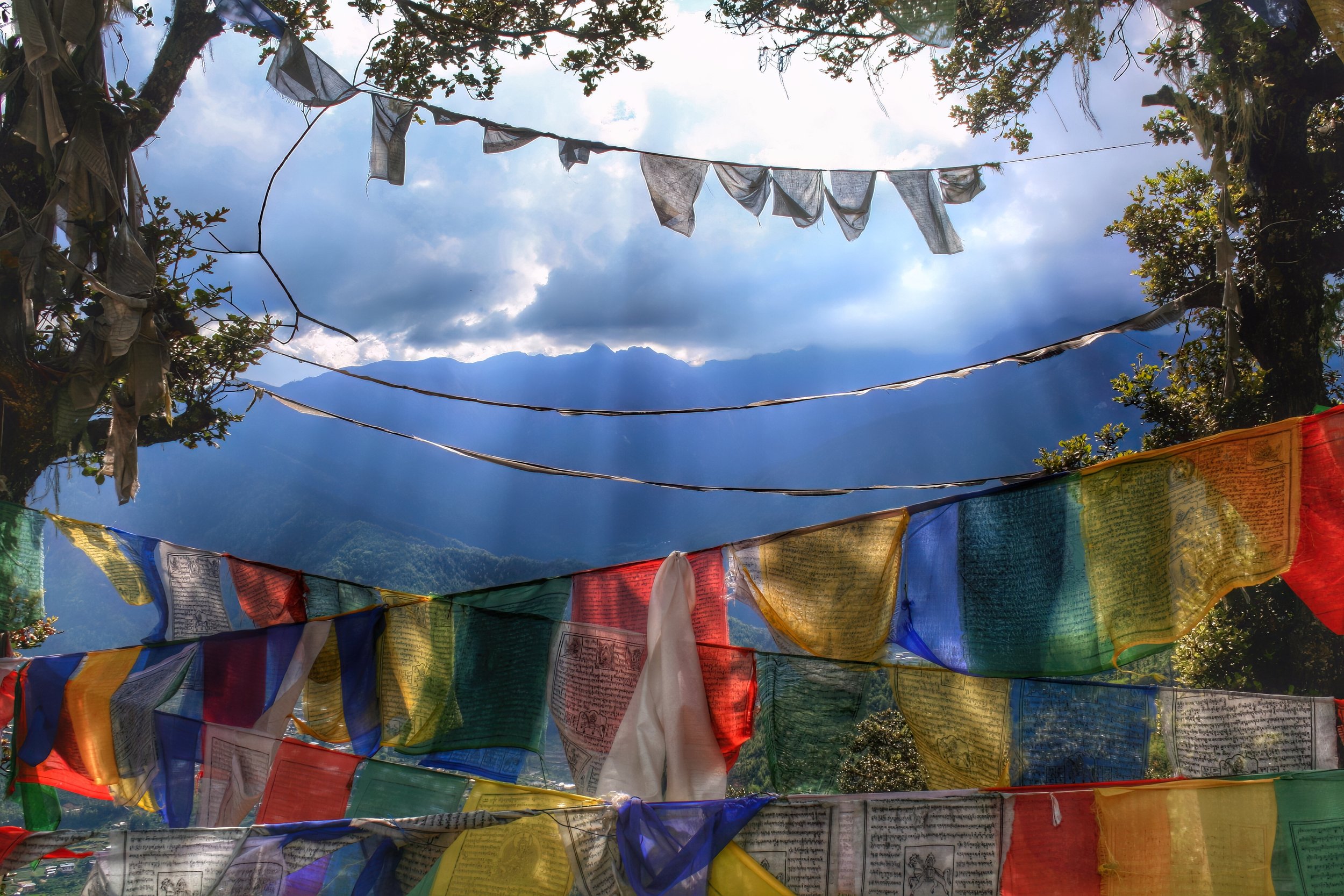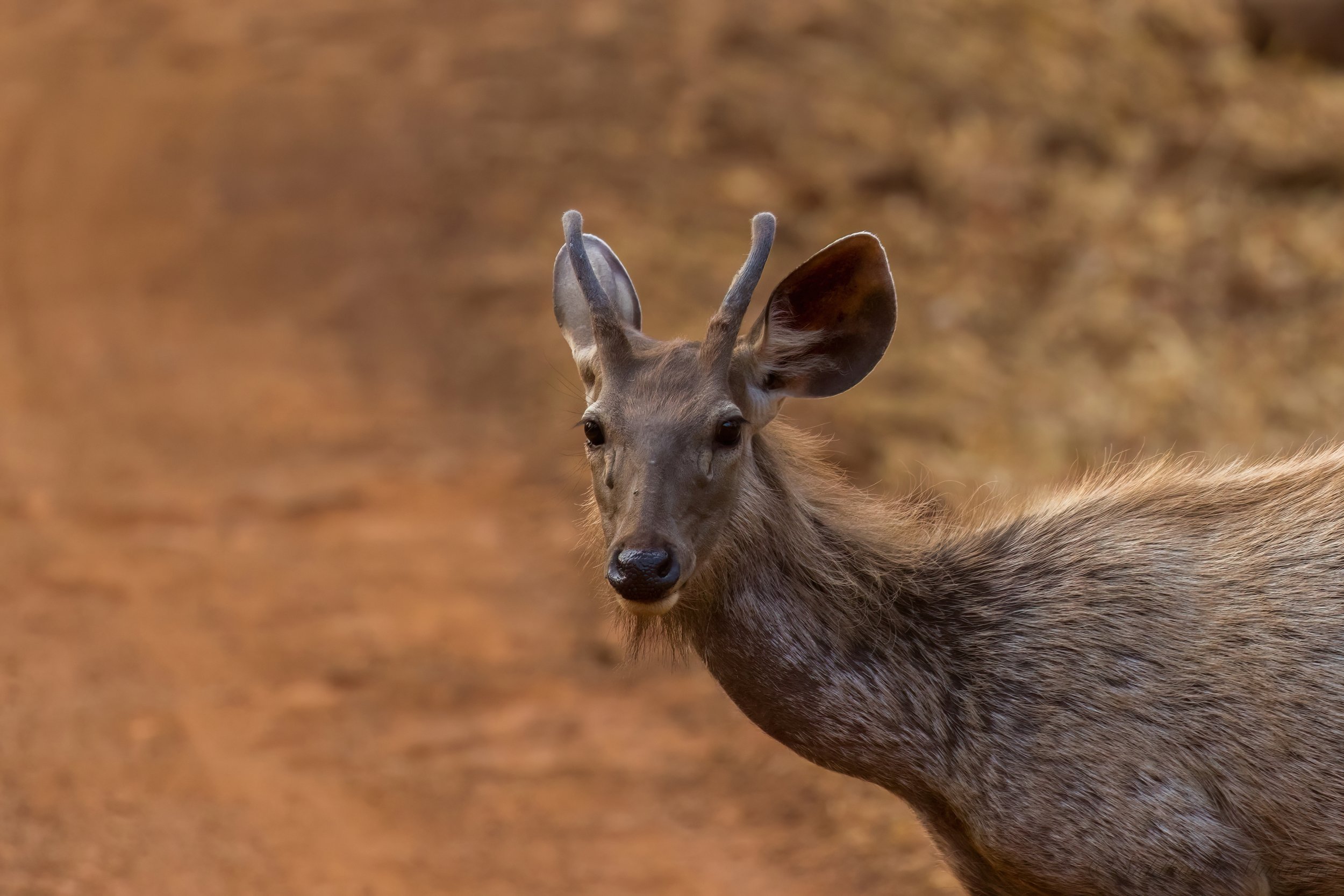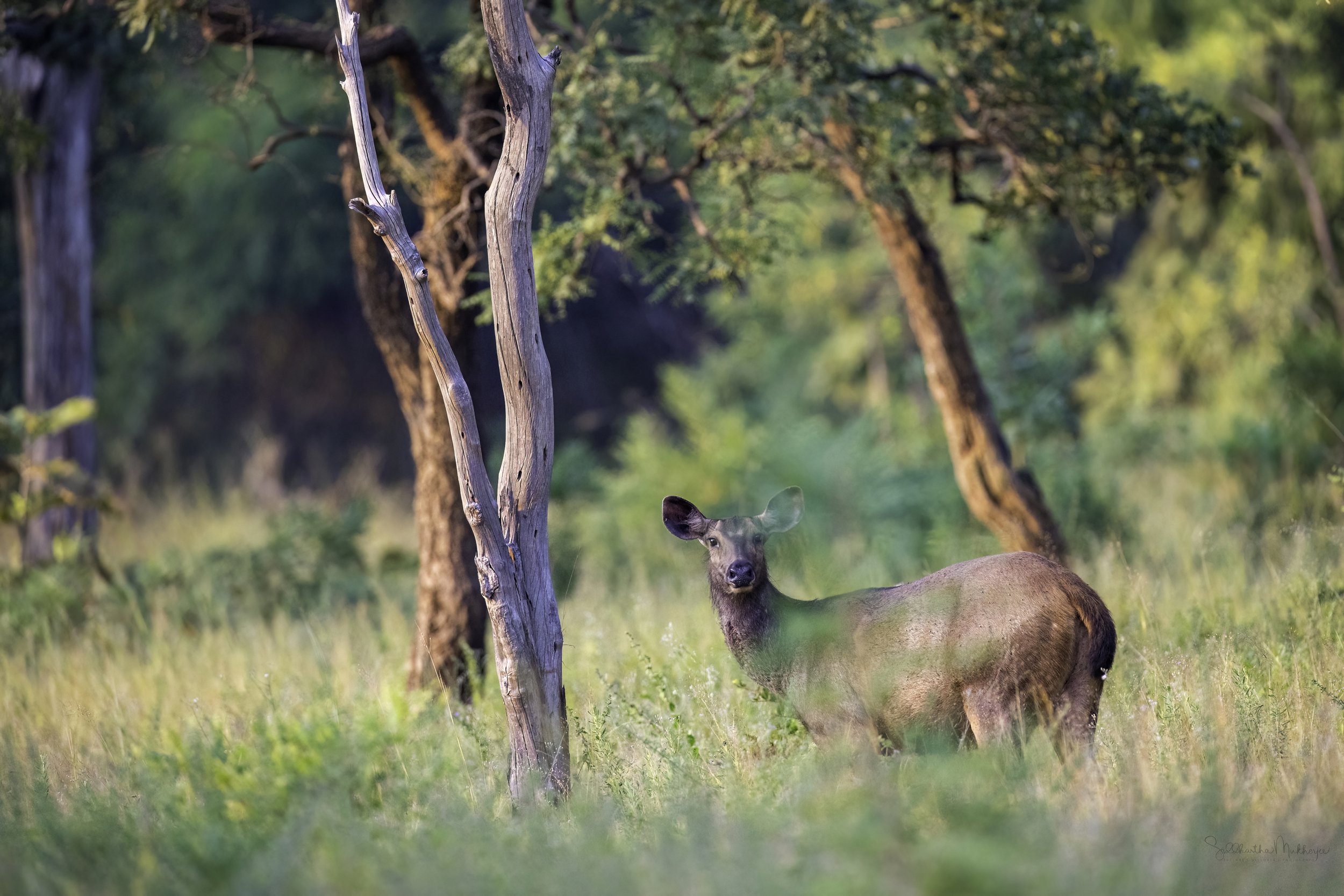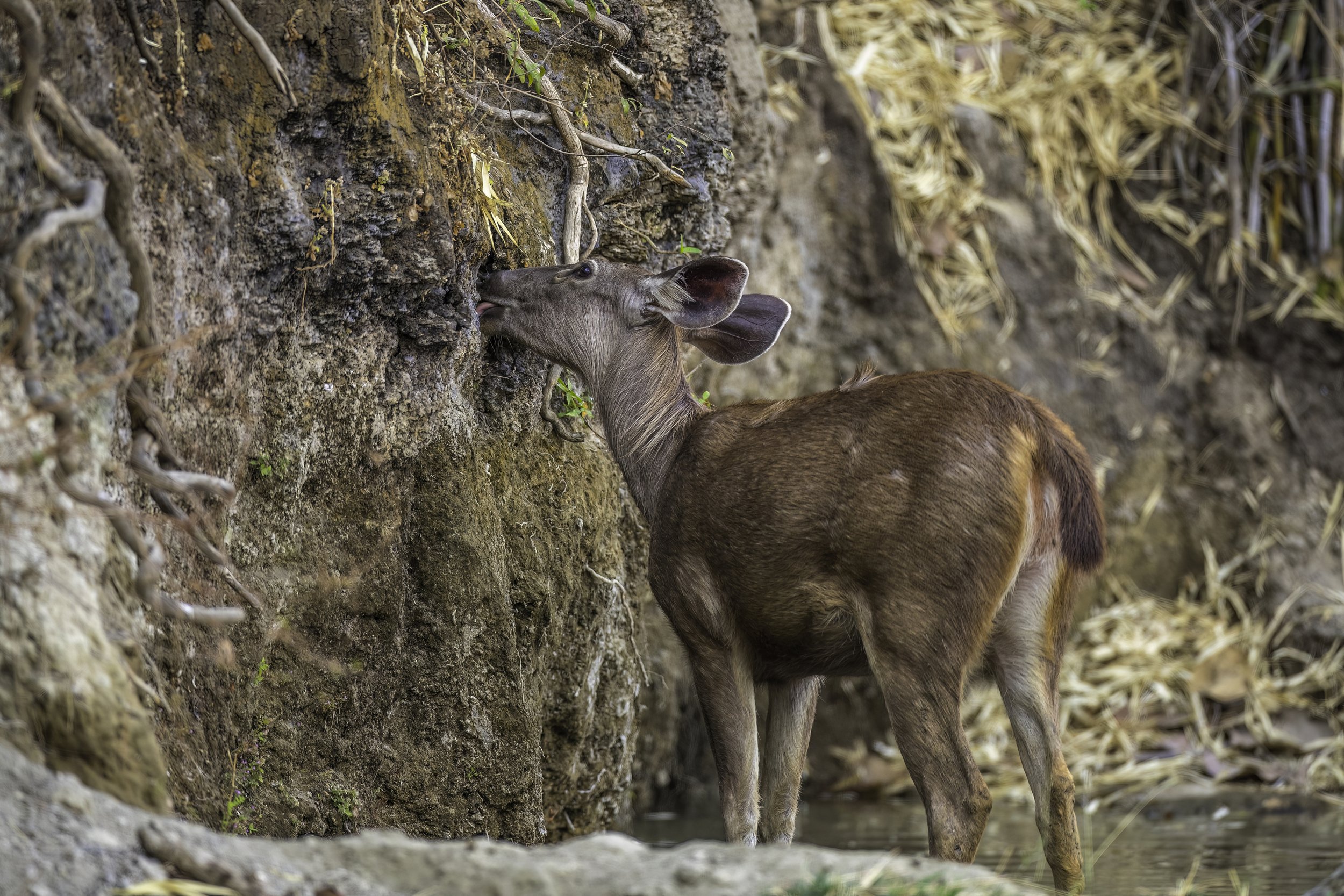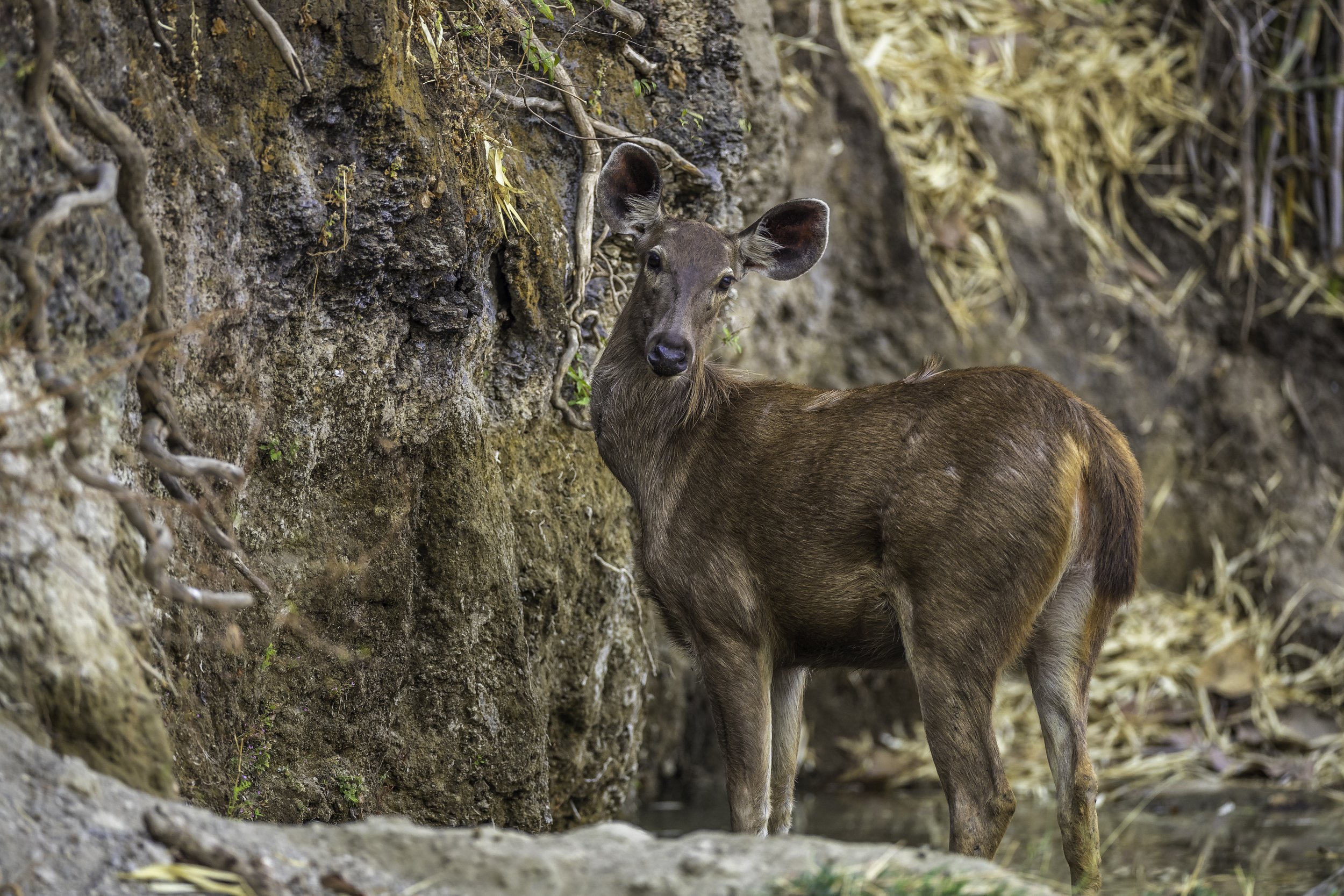Sambhar
Rusa unicolor
VULNERABLE
Sambar Deer
Jungles of India & Bhutan
My love for the jungles and its inhabitants started when I was about knee high, perched on my grandfathers lap as he taught me jungle lore and narrated the exploits of Jim Corbett. Over the years that love has gradually grown and when my brain needs a refresh, I reach out to the jungle. I first knew the leopard in Rudraprayag from the stories my grandfather narrated as Carpet Sahib tracked and finally brought it down. From then to now I have spent a lot of time traversing the jungles of India and have come across the beautiful wildlife that inhabit these lush forests. Interestingly, the other author from my childhood was the Bangalore based, India-born British hunter & writer, Kenneth Anderson, who combed the South Indian jungles hunting & photographing wildlife.
“The book of nature has no beginning, as it has no end. Open this book where you will, and at any period of your life, and if you have the desire to acquire knowledge you will find it of intense interest, and no matter how long or how intently you study the pages, your interest will not flag, for in nature there is no finality.”
The Sambhar (Rusa unicolor) are a large deer species native to the Indian subcontinent, South China & SE Asia listed as a Vulnerable Species on the IUCN Red List since 2008. Sambar have many subspecies which vary in size and appearance, and they are known as the largest Oriental deer with some adult males reaching 550kg in weight. Their populations have declined substantially due to severe hunting, local insurgency, and the industrial exploitation of their habitat.
Sambar have a thick coat of long, coarse hair which forms a dense mane around the neck, especially in males. The males can be distinguished by their antlers, as well as being slightly larger and darker than females and young. The name is also spelled Sambur, Sambhar or Sambhur. The name "sambar" is also sometimes used to refer to the Philippine deer called the "Philippine sambar", and the Javan rusa called the "Sunda sambar". But first about the habitats I have observed the sambhar - all across India and also in Bhutan.
Motithang Takin Preserve, Bhutan
Buddha Dordenma, Bhutan
A stunning land steeped in mystery and rich in culture & tradition, Bhutan is a landlocked country in South Asia located at the eastern end of the Himalayas. It is bordered to the north by China and to the south, east and west by India. To the west, it is separated from Nepal by the Indian state of Sikkim, while further south it is separated from Bangladesh by the Indian states of Assam and West Bengal. Bhutan's capital and largest city is Thimphu. Bhutan existed as a patchwork of minor warring fiefdoms until the early 17th century, when the lama and military leader Shabdrung Ngawang Namgyal, fleeing religious persecution in Tibet, unified the area and cultivated a distinct Bhutanese identity. Later, in the early 20th century, Bhutan came into contact with the British Empire and retained strong bilateral relations with India upon its independence. Bhutan is the only country to have officially adopted gross national happiness instead of the gross domestic product as the main development indicator. Bhutan's landscape ranges from subtropical plains in the south to the sub-alpine Himalayan heights in the north, where some peaks exceed 7,000 metres (23,000 ft).
Of all the countries I have seen in the world, Bhutan is the most beautiful!
The terrain is some of the most rugged in the world, characterised by huge variations in altitude. Within the 241 kilometers between the southern and northern borders, Bhutan's elevation rises from 150 to more than 7,500 metres. This great geographical diversity combined with equally diverse climate conditions contributes to Bhutan's outstanding range of biodiversity and ecosystems.
Bhutan is one of the world’s biodiversity hotspots and the world’s first and only carbon-negative country. The kingdom is home to 90 species of mammals, 770 species of bird and at least 5,400 species of plants. The tiger, one-horned rhino, golden langur, clouded leopard, hispid hare and the sloth bear live in the lush tropical lowland and hardwood forests in the south. In the temperate zone, grey langur, tiger, common leopard, goral and serow are found in mixed conifer, broadleaf and pine forests. Fruit bearing trees and bamboo provide habitat for the Himalayan black bear, red panda, squirrel, sambar, wild pig and barking deer. The alpine habitats of the great Himalayan range in the north are home to the snow leopard, blue sheep, marmot, antelope and Himalayan musk deer. Flora and birds abound with more than 770 species of bird and 5,400 species of plants known to occur throughout the kingdom.
To most people, the Kingdom of Bhutan is the land of mountain top monasteries and religious experiences. But when you visit Bhutan, you realize that there is much more to this exotic kingdom than meets the eye. It lies among a spectacularly rugged terrain coated in lush greenery. More than 72% of Bhutan’s territory is covered by forest and more than half of the country’s landmass falls within protected areas that are home to the incredibly charismatic Bhutan animals. One such place is the Motithang Takin Preserve located in the Motithang district of Thimphu, Bhutan. It is a wildlife reserve area for Takin, the national animal of Bhutan. Originally a mini-zoo, it was converted into a preserve when it was discovered that the animals refrained from inhabiting the surrounding forest even when set free. One of the animals I photographed here was the Sambhar.
I wrote briefly about Bhutan in an earlier blog with some photos of the stunning landscapes. Read it here.
Tadoba Andhari Tiger Reserve
Almost at the heart of the nation lies the jewel of Vidarbh, “Tadoba National Park and Tiger Reserve”. Also known as the "Tadoba Andhari Tiger Reserve" it is the oldest and largest National Park in the state of Maharashtra and one of 47 Project Tiger reserves existing in India.
Tadoba is a jungle where, early in the day, the sun follows one like a lodestar through the tangled heads of the trees and as the day progresses it burns with a blinding exquisiteness that makes us shield our eyes and bless our existence. The light is lustrous in the open spaces and seemed undistllled from heaven to earth seeming like a laser show at times as gem clear beams filter through the trees. The warmth of it settles over our faces like a silken mask and life is a golden joy. That is the thing about the seraph-light of this jungle; it can sweep down like the handloom of the gods one moment, pure and clear and long of line.
Tadoba lies in the Chandrapur district of Maharashtra state, once ruled by the Gond Kings in the vicinity of the Chimur Hills, and is approximately 150 km from the closest major city, Nagpur. The total area of the tiger reserve is 1,727 km², which includes the Tadoba National Park, created in the year 1955. The Andhari Wildlife Sanctuary was formed in the year 1986 and was amalgamated with the park in 1995 to establish the present Tadoba Andhari Tiger Reserve. The word 'Tadoba' is derived from the name of God "Tadoba" or "Taru," venerated by the local adivasi (tribal) people of this region and "Andhari" is derived from the name of the river Andhari flowing in this area. Legend holds that Taru was a village chief killed in a mythological encounter with a tiger. Taru was deified and a shrine now exists beneath a large tree on the banks of the Tadoba Lake. The temple is frequented by the adivasis between the months of December through January.
Home to some of central India’s best native woodland bird species, about 181 including endangered and water birds, the park also boasts leopards, sloth bear, the Indian bison (Gaur), Nilgai, Dhole, Striped Hyena, small Indian Civet, numerous Jungle Cats, Chital (Axis Deer), Sambar, Barking Deer, Four-horned antelope, Marsh Crocodiles, a profusion of Langurs and Rhesus Macaques and a good measure of reptiles like the Indian Python, Cobra and numerous other species. Tadoba, unfortunately, also has a high rate of man tiger conflict. Several instances have also been reported of wildlife killing domestic livestock and there are villages still within the forest contrary to the efforts of the Forest department so we were told. Note it is man conflicting with nature and not the other way round.
As of May 2020, there were 115 royal bengal tigers, 151 leopards estimated in Tadoba and the surrounding buffer areas. A booming population supported by the incredible and diverse biodiversity making the reserve a paradise for tiger enthusiasts who have the choice of some of the best forest tracks in the country.
This is not a reserve where one will say I saw a bengal tiger, here one will say I saw the Telia Sisters, I saw the huge Matkasur, I saw beautiful Maya, I saw the gorgeous Choti Tara. Tadoba today has probably the highest Sighting Rating Index (SRI) for the tigers in the country with SRI defined as the number of successful sighting safaris vs the total number of safaris undertaken in the prior 28 days.
Pench National Park
Pench National Park, nestled in the heart of India in the lower southern reaches of the Satpura hills, sprawls a massive 758 km² across the states of Madhya Pradesh & Maharashtra. In Madhya Pradesh it is located in the districts of Seoni and Chhindwara. Named after the pristine River Pench it was immortalised by Rudyard Kipling in his Jungle Book. Every year millions make their way here to spot Akela (the Indian Wolf), Baloo (the Sloth Bear), Bagheera (the Black Panther) and Shere Khan (the Royal Bengal Tiger). It was declared a sanctuary in 1965 and elevated to the status of national park in 1975 and enlisted as a tiger reserve in 1992. The area has always been rich in wildlife dominated by fairly open canopy, mixed forests with considerable shrub cover and open grassy patches. The high habitat heterogeneity favours a high population of Chital and Sambhar. Pench tiger reserve has highest density of herbivores in India (90.3 animals per km²).
Pench has a glorious history of natural wealth and unique cultural richness described in several classics ranging from the Ain-e-Akbari to the Jungle Book. Several natural history books like Strendale’s “Seonee - Camplife in the Satpuras” & Forsyth’s “Highlands of Central India” present a detailed panorama of these forests.
The forest, lush and green in the monsoon, also harbours a wide range of faunal species some of which figure prominently in the IUCN Red List. Pench National Park also was the location used by the BBC for the innovative wildlife series Tiger: Spy in the Jungle, a three-part documentary narrated by Sir David Attenborough which used concealed cameras, placed by elephants, in order to capture intimate tiger behaviour and also retrieved footage of various other fauna in the reserve. The programme aired for the first time in March 2008 and ended a month later.
Tipeshwar Wildlife Sanctuary
Tipeshwar Wildlife Sanctuary has emerged as a successful tiger-cradle in the Eastern Vidarbha Landscape (one of the prominent Tiger Conservation Landscapes of India) and has demonstrated the potential to populate nearby tiger reserves like the Kawal Sanctuary in Telangana. However, like almost all other tiger reserves in India, Tipeshwar too, is plagued by the usual suspects – it is surrounded by densely populated and human dominated landscape with all the associated baggage that unhindered human activity brings - poaching, cattle grazing, trespassing etc., development – illegal mining, highway expansion etc., forest and prey-base degradation, human-tiger conflict etc. There are also a number of villages within the sanctuary area and their inhabitants are dependent on the forest for their livelihood.
But that said Tipeshwar has gone from being a sink, collecting surplus tigers from the larger sanctuaries, to becoming a source, generating increasing tiger numbers with village relocation playing a particularly important part. The three villages in the sanctuary - Tipeshwar, Pitapingri and Maregaon - mostly dominated by the Kolam tribe were relocated, I think, in 2014-15.
Five tribes occupy the Tipeshwar forest region viz., Pardhan, Gond, Kolam, Navbuddha & Kunbi, of which the former three are said to be aboriginal. The total populations of these tribes range from a few hundred to thousand and are seemingly vanishing; these tribes are stricken with poverty with a high mortality rate in infants, and a high incidence of sickle cell disease. Albeit in the recent years the increase in tourism has improved their condition to some degree.
The inviolate spaces created for the tigers through this village relocation exercise and additional measures such as the introduction of prey like sambar has helped the increase in the population of tigers. But on this trip, although we did see some tigers, I was entranced by the magnificence of the Nilgai. Their sheer size and grace needs to be observed to be believed. Here are some photographs I was able to gather of the Nilgai in Tipeshwar Wildlife Sanctuary.
Read about some of the tigers and the diverse wildlife inhabiting all these sanctuaries.
Sambhar/ Sambar/ Sambur/ Sambhur
The sambar (Rusa unicolor ) is a large deer native to the Indian subcontinent and Southeast Asia that is listed as a vulnerable species on the IUCN Red List since 2008. Populations have declined substantially due to severe hunting, local insurgency, and industrial exploitation of habitat.
The appearance and the size of sambar vary widely across its range, which has led to considerable taxonomicconfusion in the past; over 40 different scientific synonyms have been used for the species. In general, they attain a height of 102 to 160 cm at the shoulder and may weigh as much as 546 kg, though more typically 100 to 350 kg. Head and body length varies from 1.62 to 2.7 m, with a 22 to 35 cm tail. Individuals belonging to western subspecies tend to be larger than those from the east, and females are smaller than males. Among all living cervid species, only the moose and the elk can attain larger sizes.
Sambar deer are light brown or dark with a grayish or yellowish tinge. The underparts are paler. Old sambars turn very dark brown, almost the color black. Their coat of dark short hair is coarse, and their undersides have creamy white to light brown hair. The color of the coat is usually consistent around the body, but it can vary from almost dark gray to yellowish-brown. Males have unique stout, rugged antlers with three points, or tines. Their tail is quite long for deer, generally black on top and dirty white or whitish underneath. Sambars have long, strong legs, the upper color being dark brown, with the inner parts of the legs a paler or dirty white. Their brownish-gray ears are long. Adult males and pregnant or lactating females possess an unusual hairless, blood-red spot located about halfway down the underside of their throats. This sometimes oozes a white liquid and is apparently glandular in nature.
The crest on the neck is also used as sexual ornamentation as males in breeding condition display a swollen neck, which is intensified by mud wallowing, which makes the individual appear larger and darker. Mating males also spray their bodies and the ground with urine, before rubbing their horns in the soil and rubbing them high on trees standing on their hind legs.
The large, rugged antlers are typically rusine, the brow tines being simple and the beams forked at the tip, so they have only three tines. The antlers are typically up to 110 cm long in fully adult individuals. As with most deer, only the males have antlers. The shaggy coat can be from yellowish brown to dark grey in colour, and while it is usually uniform in colour, some subspecies have chestnut marks on the rump and underparts. Sambar also have a small but dense mane, which tends to be more prominent in males. The tail is relatively long for deer, and is generally black above with a whitish underside. Adult males and pregnant or lactating females possess an unusual hairless, blood-red spot located about halfway down the underside of their throats. This sometimes oozes a white liquid, and is apparently glandular in nature.
Sambar Deer are quite elusive and are most active at dusk and at night. They are predated by Indian Leopard, Bengal Tiger and Dhole, which makes them an important component of the ecosystem. Although their first instinct is to freeze when disturbed, they will confront predators with loud alarm barks, stomps and the mane will erect to make them appear more intimidating.
The sambar is distributed in much of South Asia as far north as the south-facing slopes of the Himalayas in Nepal, Bhutan and India, in mainland Southeast Asia including Burma, Thailand, Indochina, the Malay Peninsula, Indonesia (Sumatra and Borneo), Taiwan, and South China, including Hainan. In the Himalayan foothills, Myanmar, Sri Lanka, and eastern Taiwan, it ranges up to 3,500 m. It inhabits tropical dry forests, tropical seasonal forests, subtropical mixed forests with stands of conifers and montane grasslands, broadleaved deciduous and broadleaved evergreen trees, to tropical rainforests, and seldom moves far from water sources. In 2023, a study showed that sambar deer had returned to Singapore due to several escapes from zoos, after it has been believed to be extinct on the island country.
Sambhar - Range & Distribution
Sambar Deer are water-dependent, so they are never found far from water, but otherwise can be found in a broad range of forest habitats: dry deciduous forest, rainforest and mixed forests. Their range is distributed from the foothills of the Himalayan Mountains across southern Asia and reaching the islands of Taiwan, Sumatra and Borneo. They prefer the dense cover of deciduous shrubs and grasses, although the exact nature of this varies enormously with the environment because of its wide Asian range. Home range sizes are probably equally variable, but have been recorded as 1,500 ha for males and 300 ha for females in India.
Sambar are nocturnal or crepuscular. The males live alone for much of the year, and the females live in small herds of up to 16 individuals. Indeed, in some areas, the average herd consists of only three or four individuals, typically consisting of an adult female, her most recent young, and perhaps a subordinate, immature female. This is an unusual pattern for deer, which more commonly live in larger groups. They often congregate near water, and are good swimmers. Like most deer, sambar are generally quiet, although all adults can scream or make short, high-pitched sounds when alarmed. However, they more commonly communicate by scent marking and foot stamping.
Sambar feed on a wide variety of vegetation, including grasses, foliage, browse, fruit, and water plants, depending on the local habitat. They also consume a great variety of shrubs and trees and they’ve been seen congregating in large herds in protected areas such as national parks and reserves in India, Sri Lanka, and Thailand. In Taiwan, sambar along with sika deer, have been raised on farms for their antlers, which they drop annually in April to May and are highly prized for use as knife handles and as grips for handguns.
Stags wallow and dig their antlers in urine-soaked soil, and then rub against tree trunks. Sambar are capable of remarkable bipedalism for a deer species, and the stags stand to mark tree branches above them with their antlers. A stag also marks himself by spraying urine on his own face with a highly mobile penis. Despite their lack of antlers, female sambar readily defend their young from most predators, which is relatively unusual among deer. When confronted by pack-hunting dholes or feral domestic dogs, a sambar lowers its head with an erect mane and lashes at the dogs. Sambar prefer to attack predators in shallow water. Several sambar may form a defensive formation, touching rumps and vocalising loudly at the dogs. When sensing danger, a sambar stamps its feet and makes a ringing call known as "pooking" or "belling". Listen to them announce the arrival of a tiger here.
They are the favourite prey of tigers and Asiatic lions. In India, the sambar can comprise up to nearly 60% of the prey selected by the Bengal tiger. Anecdotally, the tiger is said to even mimic the call of the sambar to deceive it while hunting. They also can be taken by crocodiles, mostly the sympatric mugger crocodiles and saltwater crocodiles. Leopards and dholes largely prey on only young or sickly deer, though they can attack healthy adults as well.
The subspecies of the sambar in India and Sri Lanka are the largest of the genus, with the largest antlers both in size and in body proportions. The South China sambar of Southern China and mainland Southeast Asia is probably second in terms of size, with slightly smaller antlers than the Indian sambar. The Sumatran sambar that inhabits the Malay Peninsula and Sumatra and the Bornean sambar seem to have the smallest antlers in proportion to their body size. The Formosan sambar is the smallest subspecies, with antler-body proportions more similar to the South China sambar.
Currently, seven subspecies of sambar are recognised, although many others have been proposed.
R. u. boninensis (Bonin sambar) - the Bonin Islands (extinct)
R. u. Brooke (Bornean sambar) - Borneo
R. u. cambojensis (Mainland Southeast Asian sambar) - Mainland Southeast Asia
R. u. dejeani (South China sambar) - southern and southwestern China
R. u. equina (Malayan sambar) - Sumatra
R. u. hainana (Hainan sambar) - Hainan, China
R. u. swinhoii (Formosan sambar) - Taiwan
R. u. unicolor (Sri Lankan sambar or Indian sambar) - India, Bangladesh & Sri Lanka
Over the past thirty years, populations of Sambar Deer have declined more than 50 per cent across South-east Asia, Borneo and Sumatra. The populations in India have been more stable within the network of protected areas, but have also seen a decline outside the parks and reserves. It is thought that these declines will continue at this rate until all the populations outside protected areas disappear, which will have an effect on the predators in these habitats as they may starve or turn to livestock, increasing human-wildlife conflict.
There has also been demand for meat and antlers which has sped up the population declines.
With that let’s move onto the photos of the graceful sambhar.
‡‡‡‡‡
Motithang Takin Preserve, Bhutan
Related Posts

